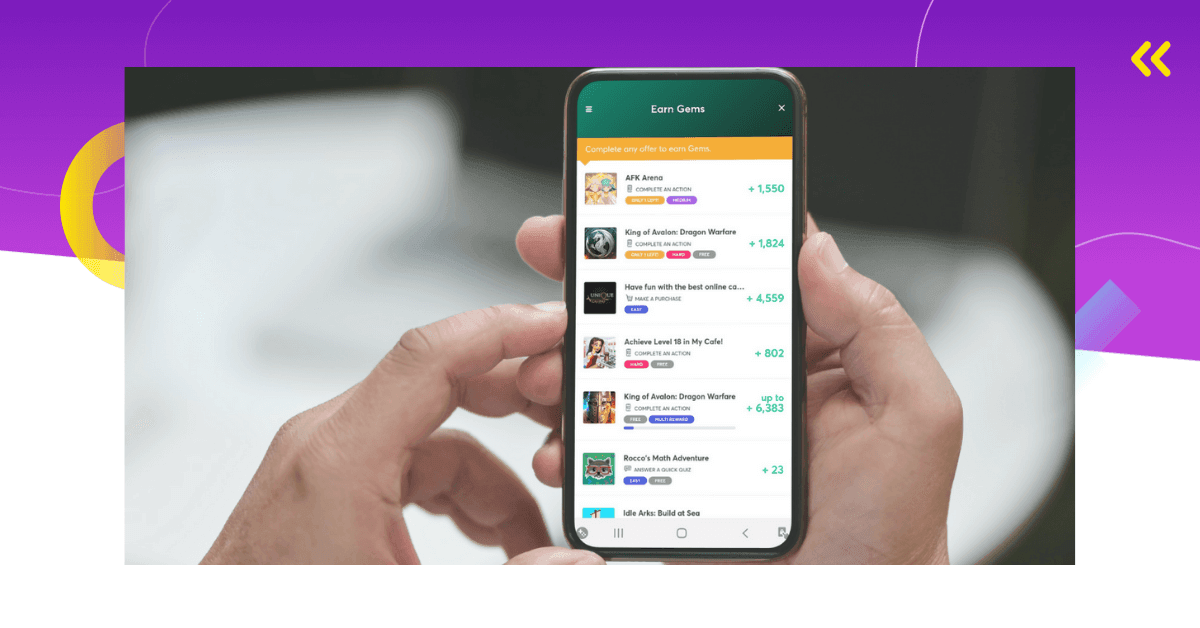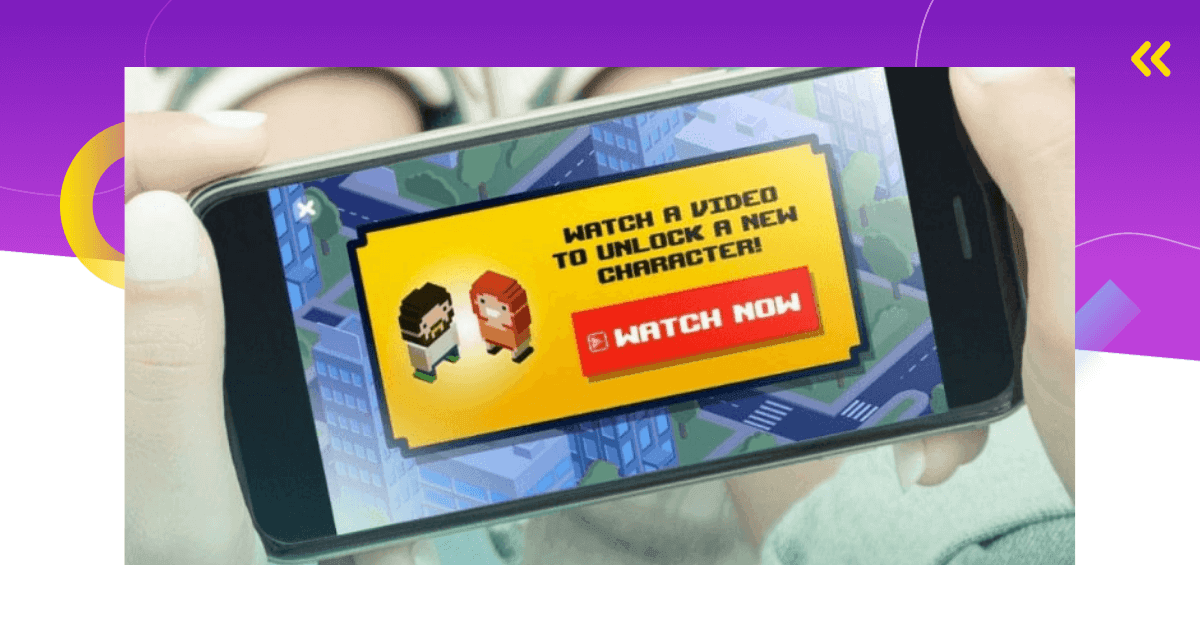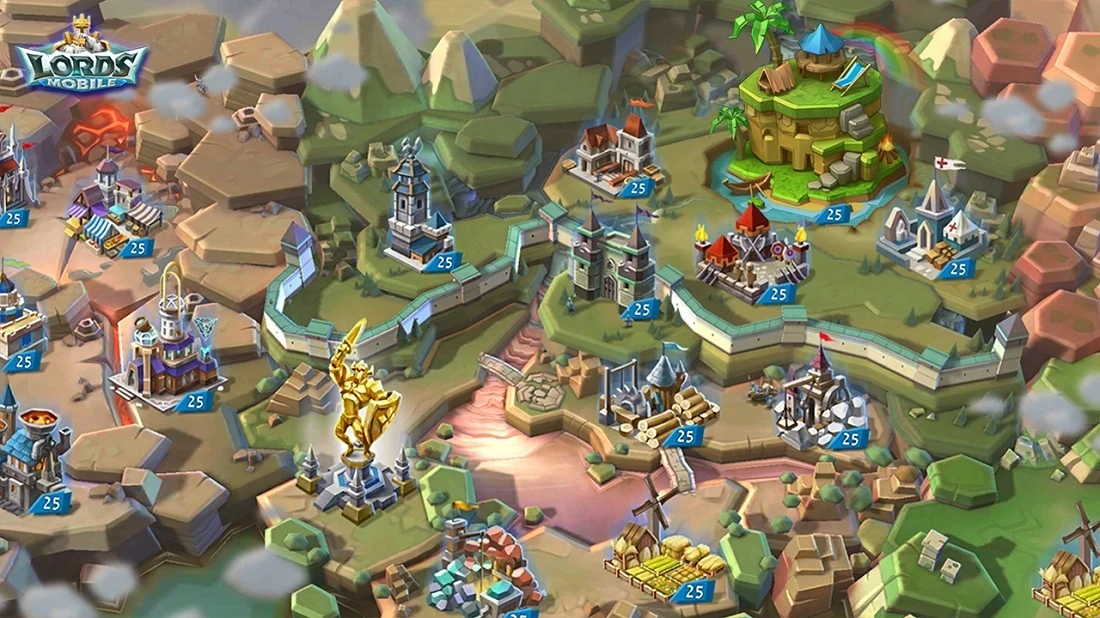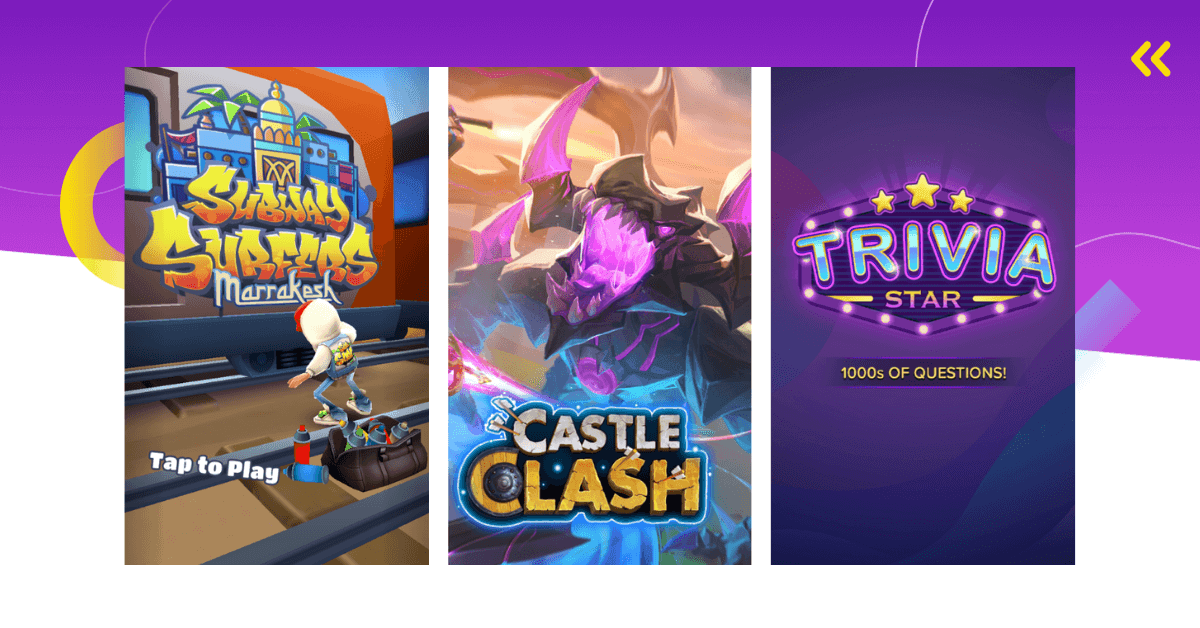Offerwalls are not the most popular ad format out there. Some even call them infamous and outdated.
Yet, there are plenty of reasons to use them.
Offerwalls can be a significant revenue stream. They work best with certain game genres and economies. Which ones? How can you get the most out of them?
We’ve got all the answers in one place.
About Offerwalls in Mobile Games
Before there were rewarded video ads, there were offerwalls. This ad format is the pioneer of opt-in rewarded advertising in mobile games.
Even though they’ve made history, they are not a thing of the past just yet. Many mobile publishers still use offerwalls.
Here’s how they work.
Offerwalls look like mini-stores inside a game. They list actions players can take to receive some kind of a reward. These actions include things like:
- Filling out a survey
- Playing a mini-game
- Signing up for a free trial
- Downloading a game
- Reaching level 5 in another game
- Making an in-app purchase in another game
Since offerwalls require a high level of engagement, the reward has to be valuable enough. Usually, this is in-game currency.
This leads me to my next point – offerwalls work better in games that include a hard currency. If there is one thing players always crave and lack, it’s hard currency.
Here’s an example of a situation where players might engage with an offerwall.
Your players are on their way to an important level in the game. However, they find out that they are out of hard currency, e.g., gems. Instead of making a purchase or waiting for in-game rewards, a pop-up that says “Earn gems” appears.
Players aren’t forced to do it but choose to engage with it. Plus, they get to pick between different offers with different amounts of gems. They make a choice depending on the time they are willing to spend, their interests, and their needs.

Offerwalls: The Good
Just like other types of in-app ads, offerwalls help developers monetize more players.
If your game is based on IAP revenue, most of your players are non-payers anyway. Therefore, if just some of them engage with offerwalls, this is already a win for you.
Some developers are afraid that in-app ads will cannibalize IAPs.
They shouldn’t be.
According to ironSource, offerwall users are 10 to 14 times more likely to make in-app purchases. The reason? Just like rewarded video ads, they give players a glimpse of the premium experience. Once they get a taste of it, they want it more.
Another “pro” for offerwalls are their eCPMs. Getting players to complete actions is not an easy task. They take time and can bring advertisers engaged, high-quality users. For this reason, advertisers pay more for offerwalls, which results in high eCPMs for publishers.
Generally, players don’t mind opt-in ads. Since users choose to engage with them, offerwalls don’t ruin the user experience. If they are customized to fit a game’s UX, even better.
Finally, offerwalls can have a positive impact on player retention. The thing is, they work best with players who are already very engaged with the game. They want hard currency badly, so they go and get it. Once the game pauses their progress, they don’t churn.
According to ironSource, retention rates among their offerwall users are 5 to 7 times higher than among those that don’t engage with them. This applies to day 7, day 14, and day 30 retention. This only proves it – loyal users enjoy offerwalls.

Offerwalls: The Not-So-Good
Now, let me point out some less good facts about offerwalls.
First of all, many ad networks don’t support offerwalls as an ad format. Therefore, the developers’ choice is limited.
Moreover, on iOS, they come with restrictions. Apple’s policy does not allow these ads to get a user to install another game or app.
For this reason, iOS offerwalls can no longer include cost per engagement (CPE) offers. This leaves iOS publishers with a limited number of offers they can bring to their players. On iOS, the main focus is on cost per action (CPA) offers. In most cases, these are different surveys or actions on the mobile web.
This is a pretty big issue. The thing is – players really like CPE offers. According to Tapjoy, 84.5% of offerwall revenues for Android publishers come from CPE offers.

Offerwall Statistics You Should Know
In order to really understand offerwalls as an ad format, let’s run some numbers on them.
According to DeltaDNA, offerwalls are the 5th most popular ad format. They are used by 15% of game publishers.
They are almost twice as popular in the mid-core and hardcore categories than in the casual one. Only 11% of casual publishers use them, in comparison to 21% of hardcore and mid-core publishers. (DeltaDNA)
It’s also interesting to observe offerwalls by metrics. We bring you engagement rates for offerwalls across different categories and genres on Android in the U.S. (ironSource)
In the mid-core category, the average engagement rate is 7%. Then there are the sports and racing categories (8%), casual category (6%), and the casino category (3%).
Out of all the genres, simulation games have the highest offerwall engagement rates – 10%.

eCPMs: Offerwalls vs. Other Ad Formats
If there is one crazy thing about offerwalls, it’s their eCPMs.
They are significantly higher than for other ad formats. Here’s just how high they are on Android in the U.S., according to ironSource.
When it comes to monetization KPIs, mid-core games take the throne. Their eCPMs average at $980, and their average ARPDAU is 8.5 cents.
RPG games have the most impressive monetization KPIs. Their eCPMs are as high as $1,670, and their ARPDAU is at 14.5 cents.
In the casual, casino, and sports & racing categories, monetization KPIs aren’t nearly as high.
Casino eCPMs are at $380, while their ARPDAU averages at 1.5 cents. Sports and racing games have a better ARPDAU – 4 cents, while their eCPMS stand at $340. The casual category’s average eCPMs are the lowest – $300, while their average ARPDAU is 2 cents.
To compare, here come the numbers for other ad formats on Android in the US.
Rewarded video ads average at $10.16. This is the second-best ad format by eCPMs, yet, they are so far behind offerwall benchmarks.
Next in line are interstitial ads, averaging at $6.38. Finally, the worst performer are banner ads – they average at $0.37.
How to Maximize Your Mobile with Offerwalls
To get the most out of offerwalls, you should follow some of the industry’s best practices.
You don’t have to do extensive research, we’ve done it for you.
We bring you six best practices for including offerwalls in mobile games.
1. Set Clear and Enticing Rewards
One of the most important things about monetizing with offerwalls is to make sure users clearly understand what they need to do and what they’ll get in return.
So the first step is to write a transparent call-to-action that explains that. For example, “Watch this video to claim free diamonds”. That way, users will know what to expect.
The next step is coming up with rewards that are enticing enough for the players to engage with the offerwall ad. What is it that players desperately need?
Common rewards include various game currencies, unlocking exclusive content, getting access to paid features, etc.
You should also consider the timing of the offer. For example, if the offerwall appears during a very difficult stage in the game, it can be a good idea to offer advantages that will help players make progress.
Whatever it may be, the reward must be valuable enough. This brings me to the next tip – how to find the ideal value.

2. Find the Ideal Reward Value
Okay, so you already know you should make your offerwall rewards valuable. But how valuable exactly?
There is no other way to find this out than to A/B test. The reward should be high enough for the user to engage with it, but not so high to make it a one-time thing.
The key question is – how many rewards should users get for every $1 you make?
If your game is based on IAPs, the answer can be found in your in-game store. For example, if a player pays $1 for 10 rubies in the store, the offerwall should bring the same value.
However, this is not the definitive answer.
For example, you may find out that your offerwalls are getting great engagement. This may be because the offerwall rewards are too valuable. And if you give out too much, this can be a problem for in-app purchases. The only way to find the ideal reward value is to test different amounts.
Finally, make sure the reward value tracks your players’ journeys. For instance, if you see a lot of players are stuck on the same levels, this is a great place to introduce an offerwall. For this reason, you need to track their in-game progress and adjust your offers.
3. Sales Are Always a Good Idea
From time to time, use these “walls” to offer more. Increase the value of rewards in the offerwall to give players even more reasons to engage with them.
Run promotions when your traffic peaks. Detect those peaks (e.g., weekends) and utilize them. You should run promotions regularly, at least once a month. Also, make sure to utilize major sale seasons like Christmas, New Years’, Valentine’s Day, etc.
If you have a promotion in your offerwall, don’t be shy about it – notify your players.
To do this, you can use alerts, pop-ups, or push notifications. It’s your call which ones to use, but make sure your players are notified.
Those players who already engaged with offerwalls are very likely to engage again. Plus, it’s a great way to reach some new offerwall users. Hopefully, they will continue to engage with them once the sale is over.
Make the benefits of the promotion clear. Highlight that players will receive increased rewards, but only for a set amount of time. If you want to create a strong sense of urgency, create a short sale timeframe.
4. Segment Your Players
Never treat all your players the same. This is one of the main rules of mobile game monetization. It applies to this ad format as well – different players should see different offerwalls.
There are many ways you can segment your players. Here are some of them:
- Spenders vs. non-spenders
- New vs. returning players
- Active vs. passive players
- Location
Here’s how you can benefit from separating spenders and non-spenders in different locations.
You segmented your players and found out that you have a lot of non-spending players in tier three regions. These players are unlikely to ever spend money on IAPs.
To make some money off them, try and get them to engage with offerwalls.
With this kind of audience, your approach can be more aggressive than with other players. For example, you can display offerwalls as soon as players launch the game.
Your goal among these players is to maximize offerwall engagement by displaying them more frequently. Just make sure not to go overboard.

5. Placement and Messaging Are Crucial
Where should you place your offers? What CTA should you use?
First of all, keep in mind that players don’t know how valuable your offerwalls are. It’s your mission to make them WANT to engage with them. For this reason, you have to make them appealing and valuable.
Your offerwalls should be visible and easily accessible. No player should have trouble finding them.
Some common offerwall placements are the home screen and the in-game store. Here’s another idea – place them in natural gameplay breaks when players run out of currency.
You can even use multiple placements. If you believe your non-spenders don’t visit the in-game store, make sure to place them somewhere where they will see them.
It’s also important to use a powerful CTA. Some examples of good offerwall CTAs are “Complete now”, “Claim now”, and “Earn free gems”.
In order to find out which one is the best choice for you – A/B test.
How will you know if you found the placement and the CTA? Track your offerwall engagement rates. According to ironSource, a good KPI to aim for is above 5%.
6. Make Them Feel like a Part of the Game
Most ad networks allow you to customize offerwalls to reflect your game’s UX.
This way, players won’t perceive it as an ad, but more as a part of the game. Here are some things you can customize to fit your game:
- Color scheme
- Header image
- Icons (e.g., hard currency)
- Currency name
If the offerwall blends in with the game, this positively affects in-game experiences. It makes the player’s transition from the game to the offerwall smoother. For this reason, there is more chance they will decide to engage with the offerwall.

7. Use the Winning Ad Combo
Want to hear about a great love story? Offerwalls and rewarded video ads. This power couple can exist separately, but together, they work best.
According to Tapjoy’s research, publishers who use both offerwalls and rewarded video ads earn 114% more than those who only use rewarded video ads. Not bad, right?
This combination works best in games with a dual-currency system. Both of these ad formats are opt-in, and both bring free rewards. For this reason, their purposes have to be different.
Rewarded videos should bring rewards with lower value, i.e., soft currency. Offerwalls require more engagement from players. Therefore, they should be more rewarding. For this reason, offerwalls should always bring hard currency.
If both of them brought hard currency, this could cause an in-game economy collapse. If there is too much currency distributed, its value can decrease. Just like if a country printed out too much money in a real-life economy.
How Popular Mobile Games Use Offerwalls: Top Examples
Looking for practical examples of games that use offerwalls? We’ve got you covered.
Here is how three different games from three different genres included offerwalls.
Design Home
As we mentioned earlier, simulation games have the best offerwall engagement numbers out of all genres.
Therefore, it comes as no surprise that one of the top simulation games – Design Home, uses them. This game comes from CrowdStar, a publisher that uses offerwalls across their portfolio (e.g., Covet Fashion).
Design Home uses hybrid monetization – it combines IAPs and IAAs. This includes both rewarded video ads and offerwall ads.
The game’s economy is based on a premium currency – diamonds. This is also the main offerwall reward.
Here’s how the offerwall appears in Design Home (played on iOS).

It can be found in the game’s store – in the “Earn diamonds” section, right next to “Watch a video”. The offerwall comes with a clear CTA – “Complete offers”.
Rewarded video ads also bring diamonds, but in much smaller amounts than offerwalls. Therefore, if players want to earn some more diamonds, they will head to the offerwall.

The offerwall itself is partially customized to fit the game. It uses its color scheme and icons, but that’s all.
Players can choose between six different offers. This includes completing surveys, making a purchase (mobile web), subscribing to different programs, etc. Since this is iOS, most offers are about completing actions.
Quizzes bring the smallest rewards, while “make a purchase” offers bring the most. It all comes down to the level of engagement they require.
One key thing can be noticed here – the offers potentially align with the players’ interests. They include things like a skinny coffee club program, a classical music subscription, and a graphic novel.
Most Design Home players are women (77%). All of these things seem like something women might be interested in.
Castle Clash: Guild Royale
This multiplayer strategy game comes from a major strategy games publisher – IGG.
Just like most strategy games, Castle Clash mainly monetizes with IAPs. Besides that, the game uses rewarded advertising. More precisely, a mix of rewarded video ads and offerwalls.
How do offerwalls fit into the mix? Let’s analyze.
This game includes a hard currency – gems, and a soft one – coins.
While rewarded video ads appear on the main screen, offerwalls don’t. Players can find them in multiple other placements. One is in the game’s resource store, and others are screens in which they need gems (hiring heroes, skipping wait times).
Rewarded video ads also help players hire heroes. However, they come with a daily limit (1), so they don’t significantly affect offerwalls.

The offerwall appears as a small sign “free” surrounded by gems. There is no CTA to make it completely clear that the players need to earn these gems themselves.

Upon clicking it, they are taken to a Tapjoy offerwall. It is solidly customized with the game’s UX. It features the game’s header image, color scheme, and icons.
On the offerwall, players have more than 30 offers to choose from. Here are some examples.
The offers that say “complete a quiz” bring the least rewards (2 gems). They take players to online quizzes and take the least of their time and hassle.
The top offer brings over 50,000 gems. It says “Explore multiple romances in Mafia City”. Basically, it requires players to play Mafia City, reach certain levels, play with ladies, and make several purchases. This is quite extreme because it takes players’ time and money.
Besides these, there are all sorts of offers like reaching certain levels, downloading and running an app, buying a cryptocurrency, etc.
On this offerwall, it’s not about aligning with the players’ interests. It is all about quantity and diversity. The assumption is – out of all these offers, players will find something they like.
Note: played on an Android device (Google Play).
Zombie Frontier 3: Sniper FPS
Zombie Frontier 3 is an action shooter game by Feelingtouch.
This game also uses the popular IAP + IAA monetization duo. It also relies on the powerful combination of rewarded video and offerwalls.
How do things work in this game? Time to find out.
Zombie Frontier has a dual economy – it includes gems (hard currency) and gold (soft currency).
Offerwalls bring players hard currency, just like they should. On the other hand, rewarded video ads help double up rewards (soft currency) after completing levels. It’s good that they don’t bring the same rewards. This way, players are motivated to engage with both ad formats.

There are two “Free gems” signs on the game’s home screen. In the game’s store, players can also see a “Free gems” section. All of these lead to offerwalls. Why am I speaking in plural?

In the game’s store, players can choose between two offerwall providers – Fyber and Tapjoy.

Tapjoy lists +30 different offers that bring anywhere from 1 to +20,000 gems. They include games from different genres, non-gaming apps, and quizzes.

Fyber’s offerwall brings even more offers. Here, they come with tags for players. Right away, they know if an offer is “hard”, “easy” “medium”, “free”, or “limited”. This way, it’s easier for players to get around.
Neither of the two offerwalls are customized to fit the game’s UX. They don’t feel like part of the game. The biggest problem with Fyber’s offerwall is that it’s vertical, while the game is horizontal. It does use brand colors, but that’s it.
Tapjoy’s offerwall doesn’t even display gems right. They are red, and in the game, they are green.
Note: played on an Android device (Google Play).

Top Ad Networks For Offerwalls
As we mentioned before, not all ad networks support offerwalls anymore. However, this doesn’t mean you have to rely on some kind of no-name network.
The list of ad networks that support them is filled with industry-leading names. Here are some of them:
- ironSource
- Tapjoy
- Chartboost
- Enhance
- Fyber
- AdAction
- Zoomd
According to Business of Apps, ironSource is one of the leading ad networks by eCPMs in the US. They are between $30 and $80 on Android and between $50 and $120 on iOS.
Some other networks with impressive eCPMs include Tapjoy that averages at $60 and Enhance with a $50 average.
When choosing between ad networks, don’t pay attention to eCPMs only. Make sure they also bring you the following benefits:
- Customization features
- Quality advertisers
- Easy to set up promotions
- Thorough reports
The Final Word
This is it, this is everything you need to know about offerwalls in mobile games.
Hopefully, this article helped you understand if they are a good fit for your game. If your answer is “yes”, make sure to stick with best practices!
Want to read more about mobile game monetization? Subscribe to our newsletter!







Comments